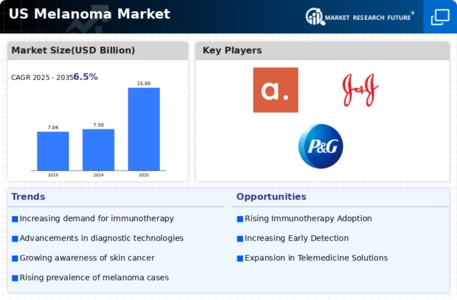Market Trends
Key Emerging Trends in the US Melanoma Market
Due to new research, awareness, and treatments, the US melanoma market has changed significantly. To aid patients and combat rising melanoma rates, market patterns are evolving. Immunotherapy for US melanoma patients is rising. Immune checkpoint drugs, such as pembrolizumab and nivolumab, have made it easier to treat melanoma. People like immunotherapy because it makes the immune system better at beating cancer. Therapist pairings are always being tested by researchers. More personalized melanoma therapies are coming. BRAF and MEK inhibitors like vemurafenib and trametinib target melanoma cell gene alterations. More people are using targeted drugs and immunotherapy combined because it works better and delays cancer growth. Personalized cancer treatment is growing in popularity. Genetic testing and molecular profiles let scientists detect changes and signals. This information helps them find the finest customized therapies. This trend suggests that individuals want more personalized and effective therapies. More patients are using adjuvant therapies to prevent melanoma recurrence following surgery. Immune checkpoint inhibitors and tailored therapies are being studied for melanoma patients to reduce the risk of recurrence and enhance long-term prognosis. Screening and early detection are gaining popularity. Public health and training initiatives teach melanoma detection. They should also regularly inspect their skin. This prophylactic strategy reduces late-stage patients and increases mortality rates. Technology and remote tracking are altering cancer treatment. Teledermatology allows users to see dermatologists from home and get timely advice. Tools can remotely follow those at risk of melanoma. Combining immunotherapy with other treatments is becoming increasingly common. Immune medicines, targeted therapies, and even standard chemotherapy are being studied to enhance treatments and avoid drawbacks. We have more real-world data to guide cancer treatment. Combining data from electronic health records and patient findings helps us understand how effectively and safely drugs perform in real-world medical scenarios. More services than ever aid and fight for patients. Melanoma patients may share their tales, acquire information, and advocate for new medicines via support groups and online forums. Patients are wiser and more powerful due to this tendency. Despite advancements, new cancer drugs are still expensive and hard to acquire. Drug costs and insurance coverage may prevent some individuals from receiving treatment. These concerns must be resolved so everyone may get cutting-edge therapies.














Leave a Comment